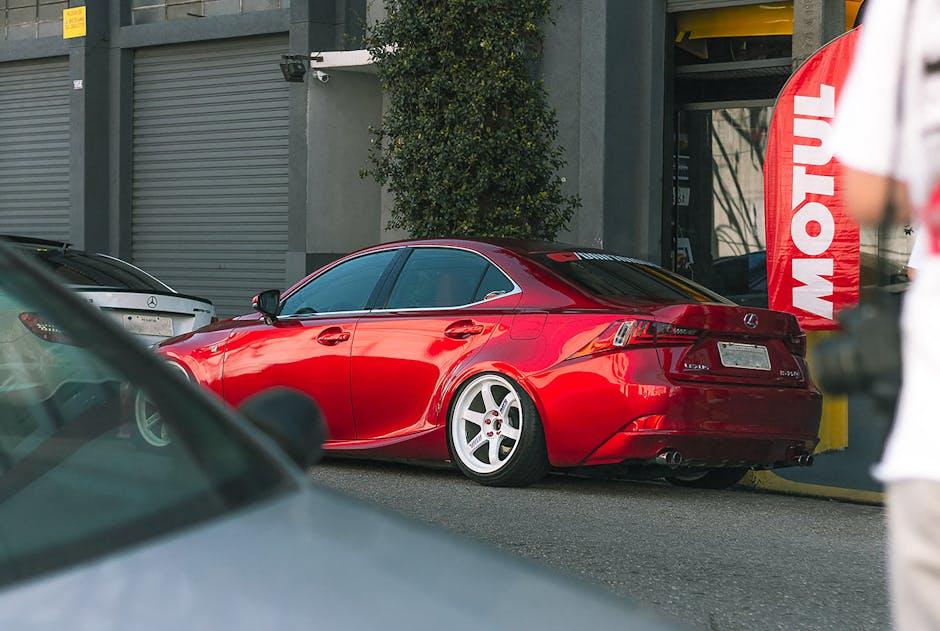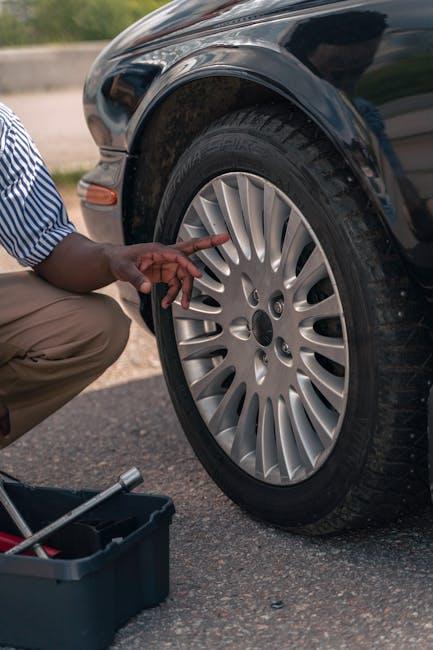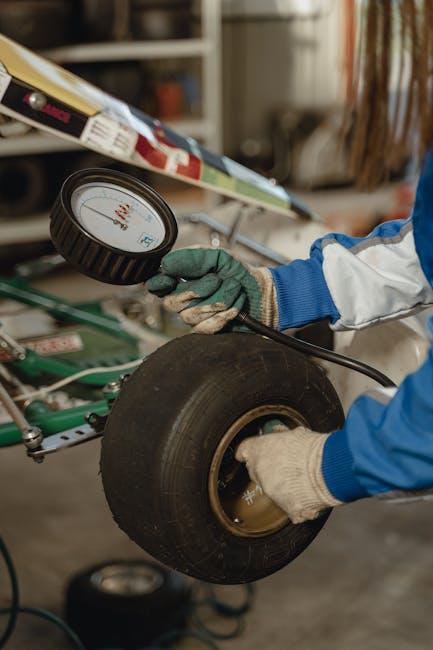Imagine cruising down a quiet road when suddenly, your car seems determined to veer left or refuse the gentle command to stay straight. That subtle tug or persistent drift to one side isn’t just a quirk — it’s a sign from your vehicle that something isn’t quite right. Recognizing when your car pulls to one side is more than a matter of comfort; it’s a crucial clue in maintaining safety and performance. In this article, we’ll explore the telltale signs of this common driving issue and guide you through the steps to identify its cause before it pulls you off course.
Table of Contents
- Understanding the Common Causes Behind Your Car Pulling to One Side
- Signs and Symptoms to Watch For While Driving
- How to Perform a Basic Wheel Alignment Check at Home
- The Role of Tire Pressure and Tread in Vehicle Steering
- When Suspension Issues Might Be the Culprit
- Professional Solutions and Maintenance Tips to Correct Pulling
- Q&A
- To Wrap It Up

Understanding the Common Causes Behind Your Car Pulling to One Side
One of the primary reasons your vehicle might drift to one side is uneven tire pressure. When one tire has significantly less air than the others, it affects the grip and balance, causing your car to pull. Additionally, wheel alignment issues are common culprits. Misaligned wheels can result from hitting potholes, curbs, or simply wear and tear over time, leading to uneven tire wear and pulling sensations. Suspension problems, such as worn-out shocks or struts, also disrupt the vehicle’s stability and contribute to this issue, often revealing themselves through uncomfortable handling and increased steering effort.
It’s also essential to consider the condition of your braking system. A stuck brake caliper or uneven brake pad wear may cause the car to pull when applying brakes. Another subtle factor is uneven weight distribution inside the vehicle, especially when carrying heavy loads on one side. Below is a quick reference table highlighting common causes, symptoms, and potential fixes:
| Cause | Symptoms | Potential Fix |
|---|---|---|
| Uneven Tire Pressure | Car drifts; uneven tire wear | Adjust tire air pressure |
| Wheel Misalignment | Steering wheel off-center; uneven tires | Professional wheel alignment |
| Suspension Issues | Rough ride; pulling during turns | Replace worn shocks/struts |
| Brake System Problems | Pulling when braking | Brake inspection and repair |

Signs and Symptoms to Watch For While Driving
When your vehicle starts to drift or pull to one side without any steering input, it’s a clear indication that something isn’t quite right. You might notice a subtle but persistent tug in the steering wheel, forcing you to compensate by adjusting your grip. This sensation can become especially pronounced on straight, flat roads where the car should naturally track straight. Other signs include uneven tire wear, where one side of the tire appears more worn down, or a vehicle that seems to lean or tilt slightly more on one side when parked.
Be vigilant for these key symptoms that could indicate an alignment or mechanical issue:
- Steering Wheel Pull: Noticeable drift or pull to the left or right while driving.
- Uneven Tire Wear: Tires showing wear patterns that differ between left and right sides.
- Vehicle Vibration: Subtle shaking or shuddering felt through the steering wheel or floorboard.
- Uneven Brake Response: Car veers or pulls during braking, signaling potential suspension or brake issues.
| Symptom | Possible Cause |
|---|---|
| Vehicle pulls to one side | Wheel misalignment or uneven tire pressure |
| Uneven tire wear | Suspension or alignment issues |
| Shaking while driving | Imbalanced tires or worn steering components |

How to Perform a Basic Wheel Alignment Check at Home
Start by parking your car on a flat, level surface and ensure your tires are properly inflated to the manufacturer’s specifications. Place a piece of chalk or tape on the sidewall of each front tire to mark their current position. Then, using a long ruler or measuring tape, measure the distance between the front edges of the tires and record it. Repeat this measurement at the rear edges of the same tires. If the front and rear measurements differ significantly, it’s a strong indication that your wheels need alignment adjustments.
Another quick test involves observing your steering wheel’s position while driving straight on a smooth road. If the wheel is off-center or the car drifts to one side, this suggests misalignment issues. You can complement these checks by using a simple plumb line against the wheel hubs to verify vertical alignment. Regularly conducting these basic home checks can help you catch wheel alignment problems early, saving you from uneven tire wear and costly repairs down the road.
- Tools needed: Measuring tape, chalk or tape, flat surface
- Check tire pressure: Match manufacturer specs
- Measure front and rear tire distances for toe alignment
- Observe steering wheel position during straight-line driving
| Symptom | Possible Cause | Quick Home Check |
|---|---|---|
| Car pulls right | Right wheel misaligned | Measure tire distances; steering wheel off-center |
| Uneven tire wear | Incorrect toe or camber | Visual tire inspection; measure wheel positions |
| Steering wheel vibration | Imbalanced wheels | Drive slowly and feel for shakes |

The Role of Tire Pressure and Tread in Vehicle Steering
Uneven tire pressure is one of the most common culprits when your vehicle veers off to one side. When one tire is underinflated, it creates more rolling resistance, causing the vehicle to pull toward that tire. Conversely, an overinflated tire reduces contact with the road, impacting traction and stability. Regularly checking and maintaining the recommended tire pressure not only ensures smoother steering but also extends the life of your tires and improves fuel efficiency.
Alongside pressure, the condition of your tire tread plays a pivotal role in steering accuracy. Worn or uneven tread wear can lead to compromised grip, especially in wet or slippery conditions, further increasing the tendency for a vehicle to pull. Watch for signs like:
- Tread depth differences between tires on the same axle
- Visible bald spots or uneven wear patterns
- Sidewall damage that may affect tire shape
By keeping both pressure and tread quality in check, you’ll maintain balanced traction on all sides, ensuring that your car tracks straight and true down the road.

When Suspension Issues Might Be the Culprit
When your vehicle tends to drift to one side, the suspension system often plays a silent yet significant role. Worn or damaged components such as ball joints, control arms, or struts can cause uneven tension, disrupting the balance and steering alignment. This imbalance makes the steering wheel feel off-center and the car to pull, especially during turns or over uneven surfaces. Unlike tire issues that can sometimes be spotted with a simple visual inspection, suspension problems might require a detailed examination by a technician.
Keep an eye out for accompanying signs such as:
- Uneven tire wear that doesn’t align with normal usage patterns.
- Excessive bouncing after hitting bumps, suggesting worn shock absorbers.
- Vibrations in the steering wheel during acceleration or braking.
Here’s a quick comparison of suspension issues and their common symptoms:
| Suspension Component | Typical Symptom | Effect on Vehicle |
|---|---|---|
| Ball Joints | Clunking noise, loose steering | Pulls to one side, uneven wear |
| Control Arms | Vibration, poor handling | Steering drift, unstable ride |
| Struts/Shocks | Excessive bounce, harsh ride | Pull in corners, reduced control |

Professional Solutions and Maintenance Tips to Correct Pulling
Addressing the issue of a car pulling to one side requires targeted professional solutions combined with smart maintenance habits. First, a qualified mechanic will perform a series of diagnostic checks including wheel alignment, tire pressure balance, and brake system inspection. Often, uneven tire wear or misaligned wheels are the silent culprits behind uneven pulling. In some cases, suspension components or even a dragging brake caliper may need replacement to restore smooth driving dynamics. Prioritizing quality parts and accurate recalibration during these repairs is essential for both safety and longevity.
Maintaining your vehicle’s balance between service visits can significantly reduce pull-related problems. Implement a routine that includes:
- Regular tire pressure checks: Unequal pressure often causes subtle directional shifts.
- Scheduled wheel alignments: Keep your suspension geometry spot-on every 10,000 miles or as recommended.
- Brake system maintenance: Lubricate calipers and replace worn brake pads promptly.
Consider this simple maintenance checklist for easy reference:
| Maintenance Task | Recommended Frequency |
|---|---|
| Tire Pressure Check | Monthly |
| Wheel Alignment | Every 10,000 miles |
| Brake Inspection | Every 12,000 miles |
Following this balanced approach ensures your vehicle responds precisely on the road and minimizes the risk of pulling, extending tire life and enhancing driving comfort.
Q&A
Q: What does it mean when a car “pulls to one side”?
A: When a car pulls to one side, it means the vehicle tends to drift or veer left or right without the driver actively steering in that direction. It’s like the car has a mind of its own, nudging you subtly (or not so subtly) off your intended path.
Q: How can I tell if my car is pulling to one side?
A: The simplest test is to drive on a smooth, straight road and briefly let go of the steering wheel (with caution and in a safe environment). If the car drifts noticeably left or right, or if you constantly have to correct the steering to stay straight, it’s pulling to one side.
Q: Are there any signs to watch out for besides drifting?
A: Yes! Uneven tire wear, a crooked steering wheel when driving straight, or the feeling that your car “pulls” during braking are all clues. Also, if you feel the car tugging or your hands need to resist a steady pull on the wheel, it’s worth investigating.
Q: What causes a car to pull to one side?
A: The usual suspects include uneven tire pressure, misaligned wheels, worn suspension parts, or brake issues like a sticking caliper. Sometimes road camber or strong crosswinds may temporarily cause pulling, but persistent pulling is often mechanical.
Q: Should I check tire pressure first?
A: Absolutely! It’s the easiest and quickest fix. Uneven tire inflation can make your car pull like a stubborn mule. Make sure all tires are inflated to the manufacturer’s recommended levels.
Q: When should I see a professional?
A: If adjusting tire pressure doesn’t solve the problem or if you notice uneven tire wear, pulling during braking, or a crooked steering wheel, it’s time to visit a mechanic. Wheel alignment or brake system inspections are common remedies.
Q: Can driving with a pull to one side be dangerous?
A: Yes, it can compromise your control, especially at high speeds or in emergency maneuvers. It also increases tire wear and can lead to costly repairs down the line.
Q: How often should I check for pulling issues?
A: Include a quick pull test in your routine car checks every few months, or whenever you change tires or experience rough roads. Early detection keeps your car safe and your ride smooth.
Knowing if your car pulls to one side is like having a secret insight into its health. Pay attention to its subtle nudges and you’ll maintain better control on every journey.
To Wrap It Up
Understanding whether your car pulls to one side is more than just a minor inconvenience—it’s a vital clue about your vehicle’s health and safety on the road. By paying close attention to the subtle tugs and drifts during your drive, you empower yourself to catch potential issues early, saving time and costly repairs down the line. So, next time you grip the wheel and feel that unexpected lean, remember: your car is communicating. Listen carefully, take action promptly, and keep your journey smooth and steady. After all, every great trip begins with a balanced ride.
